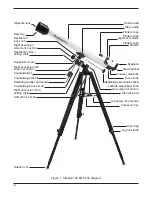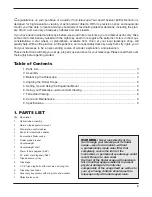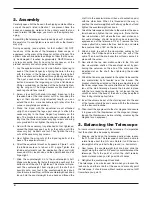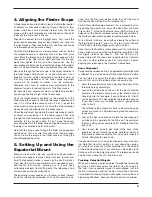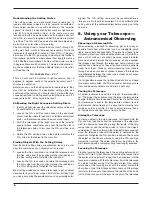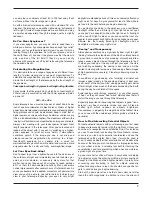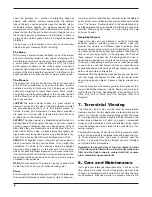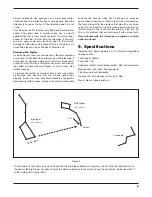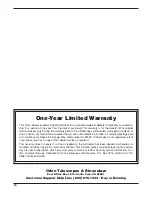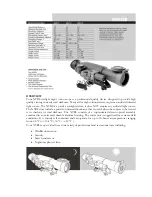
6
understanding the setting circles
The setting circles on an equatorial mount enable you to
locate astronomical objects by their “celestial coordinates.”
Every object resides in a specific location on the “celestial
sphere”; its location is denoted by two numbers: right ascen-
sion (R.A.) and declination (Dec.). In the same way, every
location on Earth can be described by its longitude and lati-
tude. R.A. is similar to longitude on Earth, and Dec. is similar
to latitude. The R.A. and Dec. values for celestial objects can
be found in any star atlas or star catalog.
The R.A. setting circle is scaled in hours, from 1 through 24,
with small hash marks in between representing 10-minute
increments (there are 60 minutes in 1 hour of R.A.). The num-
bers closest to the R.A. gear apply to viewing in the Northern
Hemisphere, while the numbers above them apply to viewing
in the Southern Hemisphere. The Dec. setting circle is scaled
in degrees (there are 60 minutes in 1 degree of declination).
So, the coordinates for the Orion Nebula listed in a star atlas
will look like this:
R.A. 5h 35.4m Dec. –5° 27'
That’s 5 hours and 35.4 minutes in right ascension, and –5
degrees (5 degrees south of the celestial equator) and 27
minutes in declination.
Before you can use the setting circles to locate objects, they
must first be calibrated. The declination setting circle was
calibrated at the factory, and should read 90° when the tele-
scope optical tube is pointing exactly along the polar axis. If it
does not read 90°, it may have to be reset.
calibrating the right ascension setting circle
1. Identify a bright star near the celestial equator and look up
its coordinates in a star atlas.
2. Loosen the R.A. and Dec. lock knobs on the equatorial
mount (not the azimuth lock knob or latitude adjustment
knob), so the telescope optical tube can move freely.
3. Point the telescope at the bright star near the celestial
equator whose coordinates you know. Center the star in
the telescope’s field of view. Lock the R.A. and Dec. lock
knobs.
4. Rotate the R.A. setting circle so the pointer indicates the
R.A. listed for that object in the star atlas.
Finding objects With the setting circles
Now that both setting circles are calibrated, look up in a star
atlas the coordinates of an object you wish to view.
1. Loosen the Dec. lock knob and rotate the telescope until
the Dec. value from the star atlas matches the reading on
the Dec. setting circle. Retighten the lock knob.
2. Loosen the R.A. lock knob and rotate the telescope until
the R.A. value from the star atlas matches the reading on
the R.A. setting circle. Retighten the lock knob.
Most setting circles are not accurate enough to put an object
dead-center in your finder scope’s field of view, but they’ll get
you close, assuming the equatorial mount is accurately polar-
aligned. The R.A. setting circle must be recalibrated every
time you wish to locate a new object. Do so by calibrating the
setting circle for the centered object before moving on to the
next one.
6. using your telescope—
astronomical observing
choosing an observing site
When selecting a location for observing, get as far away as
possible from direct artificial light such as streetlights, porch
lights, and automobile headlights. The glare from these lights
will greatly impair your dark-adapted night vision. Set up on a
grass or dirt surface, not asphalt, because asphalt radiates
more heat, which disturbs the surrounding air and degrades
the images seen through the telescope. Avoid viewing over
rooftops and chimneys, as they often have warm air currents
rising from them. Similarly, avoid observing from indoors
through an open (or closed) window, because the tempera-
ture difference between the indoor and outdoor air will cause
image blurring and distortion.
If at all possible, escape the light-polluted city sky and head
for darker country skies. You’ll be amazed at how many more
stars and deep-sky objects are visible in a dark sky!
cooling the telescope
All optical instruments need time to reach “thermal equilibri-
um.” The bigger the instrument and the larger the temperature
change, the more time is needed. Allow at least a half-hour for
your telescope to cool to the temperature outdoors. In very
cold climates (below freezing), it is essential to store the tele-
scope as cold as possible. If it has to adjust to more than a
40° temperature change, allow at least one hour.
aiming the telescope
To view an object in the main telescope, first loosen both the
R.A. and Dec. lock knobs. Aim the telescope at the object you
wish to observe by “eyeballing” along the length of the tele-
scope tube (or use the setting circles to “dial in” the object’s
coordinates). Then look through the (aligned) finder scope and
move the telescope tube until the object is centered on the
crosshairs. Retighten the R.A. and Dec. lock bolts. Then center
the object on the finder’s crosshairs using the R.A. and Dec.
slow-motion controls. The object should now be visible in the
main telescope with a low-power (long focal length) eyepiece.
Focusing the telescope
Practice focusing the telescope in the daytime before using it
for the first time at night. Start by positioning the focuser near
the center of its adjustment range. Insert an eyepiece into the
focuser and secure with the thumbscrew. Point the telescope
at a distant subject and get it in the field of view. Now, slowly
rotate one of the focusing knobs until the object comes into
sharp focus. Go a little bit beyond sharp focus until the image
just starts to blur again, then reverse the rotation of the knob,
just to make sure you hit the exact focus point. The telescope


